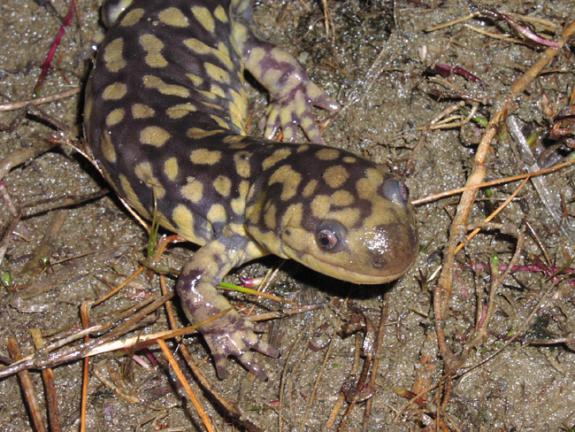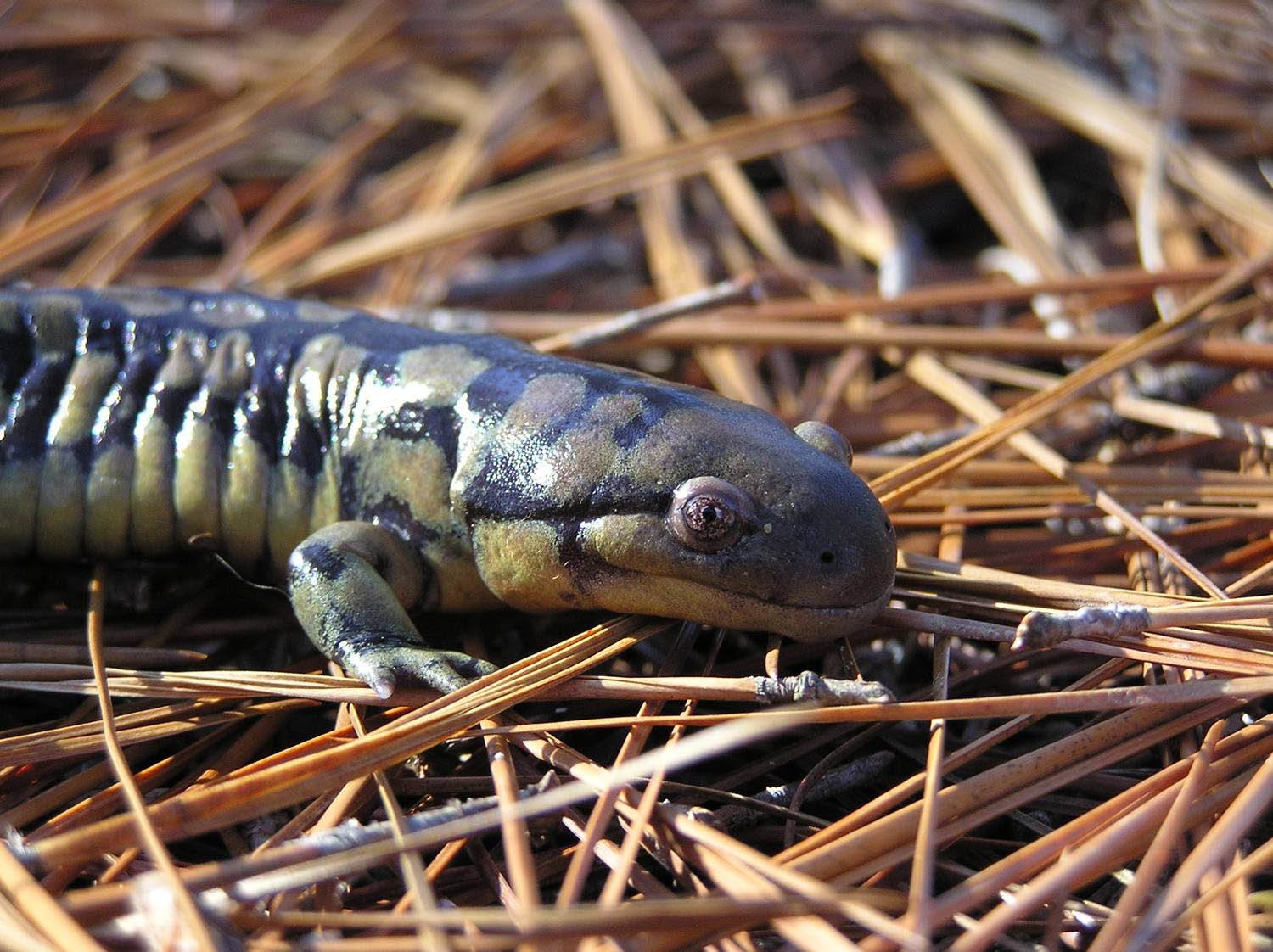The Eastern Tiger Salamander, found in Austin, Texas, is one of the largest terrestrial salamanders in North America. Its predators include badgers, snakes, bobcats, and owls, and its diet consists of worms, snails, slugs, insects, and even other salamanders.
Caring for a Tiger Salamander involves providing it with a varied diet and maintaining its habitat. These salamanders have an average lifespan of several years and are known for their thick bodies, short snouts, sturdy legs, and long tails. The life cycle of a Tiger Salamander involves breeding and the development of larvae before they transform into adults.
There are different breeds of Tiger Salamanders, each with unique characteristics and coloration.
Overview
The Eastern Tiger Salamander is one of the largest terrestrial salamanders in North America. With its thick body, short snout, sturdy legs, and long tail, it is known for its unique appearance and efficient predator abilities.
F an Eastern Tiger Salamander Eastern Tiger Salamander| Introduction to the Eastern Tiger Salamander:
The Eastern Tiger Salamander, also known as Ambystoma tigrinum, is a species of mole salamander and one of the largest terrestrial salamanders found in North America. These fascinating creatures are primarily found in the eastern parts of the United States, especially in habitats like marshes, swamps, ponds, and other wetland areas.
Let’s dive deeper into the description of this remarkable species, its size, and physical features.
Description Of The Eastern Tiger Salamander:
- The Eastern Tiger Salamander is known for its unique appearance, with a dark coloration and yellow or olive markings, resembling the stripes of a tiger.
- This species has a stout body with a broad, rounded snout and small, prominent eyes.
- The salamander’s skin is rough and covered with small bumps, which help them to retain moisture and blend in with their surroundings.
- One of the most interesting features of the Eastern Tiger Salamander is its ability to regenerate lost body parts, including limbs and even parts of its spinal cord.
- These salamanders are specifically adapted for a semi-aquatic lifestyle, with a strong tail that aids in swimming and powerful hind legs that enable them to move on land.
Size And Physical Features Of The Eastern Tiger Salamander:
- On average, adult Eastern Tiger Salamanders can grow to a length of between seven and eight inches.
- Males are generally larger than females, with longer bodies and broader heads.
- The species exhibits sexual dimorphism, with males having a more robust build and a longer, more muscular tail.
- The coloration of an Eastern Tiger Salamander varies depending on its age and location, but most individuals have a dark brown or black body with yellow or olive markings.
- Underneath their skin, these salamanders possess a series of yellow or orange spots that line their sides and extend down their tails.
These unique physical characteristics of the Eastern Tiger Salamander make them a fascinating species to study and admire. Whether dwelling on land or in water, these amphibians demonstrate remarkable adaptability and contribute to the biodiversity of their ecosystems.
Diet And Habitat
The Eastern Tiger Salamander is one of the largest terrestrial salamanders in North America. It is known for its efficient predator skills and will eat worms, snails, slugs, insects, and even other salamanders. Its habitat includes areas with moist soil and bodies of water where it lays its eggs.
The Eastern Tiger Salamander is a fascinating creature found in various parts of North America. In this section, we will explore the diet and habitat of this unique amphibian.
What The Eastern Tiger Salamander Eats:
- Worms: These slimy creatures are a staple in the diet of the Eastern Tiger Salamander.
- Frogs: The salamander is not picky and will devour frogs if given the opportunity.
- Insects: From beetles to grasshoppers, insects make up a significant portion of the salamander’s diet.
- Snails and slugs: These slow-moving mollusks provide a tasty treat for the salamander.
- Fish: In certain habitats, the Eastern Tiger Salamander will feast on small fish.
- Other salamanders: Cannibalism is not uncommon among these amphibians, and they will not hesitate to dine on their own kind.
Natural Habitat Of The Salamander:
The Eastern Tiger Salamander can be found in a variety of habitats, including:
- Wetlands: These salamanders thrive in wet areas such as marshes, swamps, and ponds.
- Forests: They seek refuge under leaves, logs, and rocks in wooded areas.
- Grasslands: Open fields and meadows also provide suitable habitats for the Eastern Tiger Salamander.
Preferred Environments And Adaptations:
- Moisture: The Eastern Tiger Salamander prefers habitats with high humidity levels to keep its skin moist and healthy.
- Burrowing ability: These salamanders have strong limbs and claws, allowing them to dig burrows in the ground for protection.
- Camouflage: Their mottled black and yellow pattern helps them blend into their surroundings, making them less visible to predators.
- Aquatic breeding: The Eastern Tiger Salamander relies on water bodies for breeding. Females lay eggs in water, where they hatch into aquatic larvae before transforming into adult salamanders.
The Eastern Tiger Salamander is a fascinating species with a diverse diet and a preference for wet habitats. Its unique adaptations allow it to thrive in various environments, making it a true survivor in the animal kingdom.
Predators And Threats
The Eastern Tiger Salamander, one of the largest terrestrial salamanders in North America, has predators such as badgers, snakes, bobcats, and owls. They are efficient predators themselves, feeding on small crustaceans, insect larvae, worms, snails, slugs, and insects.
Predators Of The Eastern Tiger Salamander:
- Badgers: Badgers are natural predators of the Eastern Tiger Salamander. They are skilled hunters and can easily catch and consume these salamanders.
- Snakes: Snakes also prey on Eastern Tiger Salamanders. They have the ability to sneak up on the salamanders and then strike and consume them.
- Bobcats: Bobcats are another predator of the Eastern Tiger Salamander. They are agile climbers and can easily catch salamanders on land or in trees.
- Owls: Owls are known to hunt and consume Eastern Tiger Salamanders. They have excellent night vision and can swoop down and capture their prey.
Threats To The Eastern Tiger Salamander Species And Its Population:
- Habitat Loss: The destruction and degradation of natural habitats, such as wetlands and forests, pose a significant threat to the Eastern Tiger Salamander species. This can be caused by urbanization, agriculture, and logging.
- Pollution: Pollution, including water pollution from pesticides and industrial waste, can harm the Eastern Tiger Salamander population. It can impact their ability to reproduce, find food, and survive.
- Invasive Species: Invasive species, like the red fire ant, can pose a threat to the Eastern Tiger Salamander population. These species compete for resources and can prey on the salamander eggs and larvae.
- Climate Change: Climate change can adversely affect the Eastern Tiger Salamander’s habitat and population. Changes in temperature and precipitation patterns can disrupt their breeding and feeding habits.
Conservation Efforts And Endangered Status:
- Endangered Status: The Eastern Tiger Salamander is listed as a species of special concern or endangered in many states. This designation highlights the need for conservation efforts to protect and preserve the species.
- Habitat Restoration: Efforts are being made to restore and conserve the natural habitats of the Eastern Tiger Salamander. This includes creating protected areas and implementing conservation practices to reduce habitat loss.
- Education and Awareness: Raising awareness about the importance of the Eastern Tiger Salamander and its habitat is crucial for its conservation. Education programs and public outreach initiatives help promote understanding and support for conservation efforts.
- Research and Monitoring: Ongoing research and monitoring of Eastern Tiger Salamander populations are essential for understanding their ecology and implementing effective conservation strategies.
- Legislation and Regulations: Governments and organizations have implemented legislation and regulations to protect the Eastern Tiger Salamander and its habitat. These measures aim to prevent habitat destruction, pollution, and the spread of invasive species.

Credit: www.conservewildlifenj.org
Frequently Asked Questions For Eastern Tiger Salamander
Are Eastern Tiger Salamanders Poisonous?
Eastern tiger salamanders are not poisonous.
Can You Keep An Eastern Tiger Salamander As A Pet?
No, you cannot keep an Eastern tiger salamander as a pet.
Are Tiger Salamander Poisonous To Humans?
No, tiger salamanders are not poisonous to humans.
Are Eastern Tiger Salamanders Rare?
Eastern tiger salamanders are not considered rare.
Conclusion
The Eastern Tiger Salamander, one of the largest terrestrial salamanders in North America, is a fascinating creature. Its impressive size and unique characteristics make it a remarkable species to learn about and appreciate. From its diet, which includes a variety of prey such as worms, frogs, insects, and even other salamanders, to its ability to thrive in different habitats, the Eastern Tiger Salamander showcases its adaptability and resilience.
This species faces various predators, including badgers, snakes, bobcats, and owls, highlighting the importance of maintaining a balanced ecosystem that supports its survival. Furthermore, understanding the lifespan and life cycle of the Eastern Tiger Salamander provides insight into its growth and reproductive patterns.
As we explore the world of these remarkable creatures, it is crucial to recognize their significance in the natural world. By raising awareness and implementing conservation efforts, we can help preserve their habitats and ensure their continued existence for future generations to admire and enjoy.
Let us embrace the wonder of the Eastern Tiger Salamander and work together to protect its place in our ecosystem.
